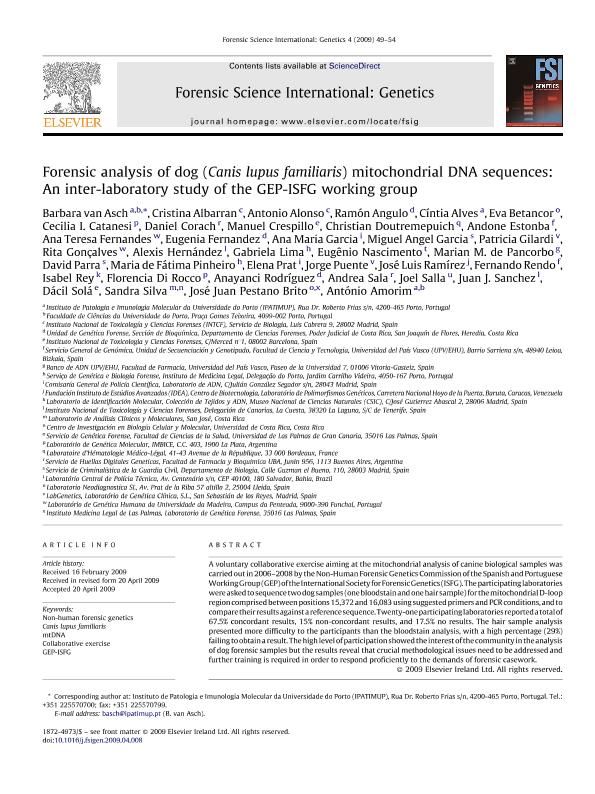Artículo
Forensic analysis of dog (Canis lupus familiaris) mitochondrial DNA sequences: An inter-laboratory study of the GEP-ISFG working group
van Asch, Barbara; Albarran, Cristina; Alonso, Antonio; Angulo, Ramón; Alves, Cíntia; Betancor, Eva; Catanesi, Cecilia Ines ; Corach, Daniel
; Corach, Daniel ; Crespillo, Manuel; Doutremepuich, Christian; Estonba, Andone; Fernandes, Ana Teresa; Fernandez, Eugenia; Garcia, Ana Maria; Garcia, Miguel Angel; Gilardi, Patricia; Gonçalves, Rita; Hernández, Alexis; Lima, Gabriela; Nascimento, Eugênio; de Pancorbo, Marian M.; Parra, David; Pinheiro, Maria de Fátima; Prat, Elena; Puente, Jorge; Ramírez, José Luis; Rendo, Fernando; Rey, Isabel; Di Rocco, Florencia
; Crespillo, Manuel; Doutremepuich, Christian; Estonba, Andone; Fernandes, Ana Teresa; Fernandez, Eugenia; Garcia, Ana Maria; Garcia, Miguel Angel; Gilardi, Patricia; Gonçalves, Rita; Hernández, Alexis; Lima, Gabriela; Nascimento, Eugênio; de Pancorbo, Marian M.; Parra, David; Pinheiro, Maria de Fátima; Prat, Elena; Puente, Jorge; Ramírez, José Luis; Rendo, Fernando; Rey, Isabel; Di Rocco, Florencia ; Rodríguez, Anayanci; Sala, Adriana Andrea
; Rodríguez, Anayanci; Sala, Adriana Andrea ; Salla, Joel; Sanchez, Juan J.; Solá, Dácil; Silva, Sandra; Pestano Brito, José Juan; Amorim, António
; Salla, Joel; Sanchez, Juan J.; Solá, Dácil; Silva, Sandra; Pestano Brito, José Juan; Amorim, António
 ; Corach, Daniel
; Corach, Daniel ; Crespillo, Manuel; Doutremepuich, Christian; Estonba, Andone; Fernandes, Ana Teresa; Fernandez, Eugenia; Garcia, Ana Maria; Garcia, Miguel Angel; Gilardi, Patricia; Gonçalves, Rita; Hernández, Alexis; Lima, Gabriela; Nascimento, Eugênio; de Pancorbo, Marian M.; Parra, David; Pinheiro, Maria de Fátima; Prat, Elena; Puente, Jorge; Ramírez, José Luis; Rendo, Fernando; Rey, Isabel; Di Rocco, Florencia
; Crespillo, Manuel; Doutremepuich, Christian; Estonba, Andone; Fernandes, Ana Teresa; Fernandez, Eugenia; Garcia, Ana Maria; Garcia, Miguel Angel; Gilardi, Patricia; Gonçalves, Rita; Hernández, Alexis; Lima, Gabriela; Nascimento, Eugênio; de Pancorbo, Marian M.; Parra, David; Pinheiro, Maria de Fátima; Prat, Elena; Puente, Jorge; Ramírez, José Luis; Rendo, Fernando; Rey, Isabel; Di Rocco, Florencia ; Rodríguez, Anayanci; Sala, Adriana Andrea
; Rodríguez, Anayanci; Sala, Adriana Andrea ; Salla, Joel; Sanchez, Juan J.; Solá, Dácil; Silva, Sandra; Pestano Brito, José Juan; Amorim, António
; Salla, Joel; Sanchez, Juan J.; Solá, Dácil; Silva, Sandra; Pestano Brito, José Juan; Amorim, António
Fecha de publicación:
01/2009
Editorial:
Elsevier Ireland
Revista:
Forensic Science International: Genetics
ISSN:
1872-4973
Idioma:
Inglés
Tipo de recurso:
Artículo publicado
Clasificación temática:
Resumen
A voluntary collaborative exercise aiming at the mitochondrial analysis of canine biological samples was carried out in 2006-2008 by the Non-Human Forensic Genetics Commission of the Spanish and Portuguese Working Group (GEP) of the International Society for Forensic Genetics (ISFG). The participating laboratories were asked to sequence two dog samples (one bloodstain and one hair sample) for the mitochondrial D-loop region comprised between positions 15,372 and 16,083 using suggested primers and PCR conditions, and to compare their results against a reference sequence. Twenty-one participating laboratories reported a total of 67.5% concordant results, 15% non-concordant results, and 17.5% no results. The hair sample analysis presented more difficulty to the participants than the bloodstain analysis, with a high percentage (29%) failing to obtain a result. The high level of participation showed the interest of the community in the analysis of dog forensic samples but the results reveal that crucial methodological issues need to be addressed and further training is required in order to respond proficiently to the demands of forensic casework.
Archivos asociados
Licencia
Identificadores
Colecciones
Articulos(IMBICE)
Articulos de INST.MULTIDISCIPL.DE BIOLOGIA CELULAR (I)
Articulos de INST.MULTIDISCIPL.DE BIOLOGIA CELULAR (I)
Articulos(OCA HOUSSAY)
Articulos de OFICINA DE COORDINACION ADMINISTRATIVA HOUSSAY
Articulos de OFICINA DE COORDINACION ADMINISTRATIVA HOUSSAY
Citación
van Asch, Barbara; Albarran, Cristina; Alonso, Antonio; Angulo, Ramón; Alves, Cíntia; et al.; Forensic analysis of dog (Canis lupus familiaris) mitochondrial DNA sequences: An inter-laboratory study of the GEP-ISFG working group; Elsevier Ireland; Forensic Science International: Genetics; 4; 1; 1-2009; 49-54
Compartir
Altmétricas



